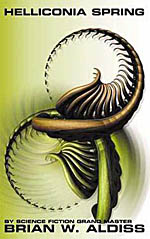
![]() Rhondak101
Rhondak101
1/30/2012
![]()
Aldiss’ Helliconia Spring has been on my reading list for a long time. I was intrigued by the premise: a planet in a binary system whose long year, or the journey around the brighter, further sun, takes about 2600 Earth years. This means that each change of season is the first that the population has ever seen and seems cataclysmic in a world without any records. This book tells the story of the planet Helliconia as it moves from a world of snow, cold and isolation to a world of warmth, growth, and expansion.
In my opinion, the story does not live up to the premise Aldiss presents. The edition of the novel I read was about 430 pages long. I only became interested in the story around page 230, and unfortunately, I never really became interested in any of the characters, who are generally one-dimensional and whose actions often seem random rather than a part of any greater motivation.
Besides the “human” civilizations on the planet, there are the phagors and Earth humans who observe the planet from above on space station Avernus. He creates the phagors as mankind’s enemy. The phagors are an intelligent type of biped, who evolved separately from the humans. Their society consists of nomadic “herds” that ride on their own domesticated animals. The people on the planet are under continual threat from them. The Earth humans are only watchers. Their observations are beamed to Earth where the activities of Helliconia have become a type of reality show. Earth’s residents, one thousand years in Helliconia’s future, attend public theaters to watch. During the first two-thirds of the book (when the readers are not told about the broadcast function of the space station), the Avernus parts seem disruptive. Only at the end do these Avernus sections add anything to the story. However, Aldiss does not explore the interesting implications that come with the Avernians’ knowledge nor the impact of this reality television back on Earth.
As I read, I starting giving Aldiss the same advice that I give my students when they write academic papers: (1) show, don’t tell; (2) don’t be afraid to cut; and (3) develop your ideas. The first ninety pages of the novel could really benefit from this advice. This section is a prologue of Yuli, the founder of the town that Aldiss will feature in the second part of the novel. Yuli’s adventures are often reported rather than shown. And, in at least one of these reports, Aldiss creates a plot hole that was hard for me to overcome. Yuli’s connection to the latter part of the novel is tangential, and I’m not the only reviewer who has wondered if this part was even necessary.
Aldiss’ strength appears in his ideas that demonstrate how the ecology and the economy of the planet awake. He traces the society of Embruddock’s movement from stationary hunter-gatherers to agrarians to a type of medieval village economy, with the development of bridges, mills and money. The moves that he makes using alien flora and fauna are interesting, but I wish that he’d spent more time showing us how these accomplishments come about. However, it is hard to believe that the community of Embruddock can move from hunter-gathers to medieval tradesmen during one lifetime—no matter how fast the world’s ecology is changing. In the end, Aldiss weaves an interesting symbiosis between the microbes, flora, fauna, and the civilizations on the planet. Unfortunately, this intriguing idea about the symbiosis came too late to make me like the book. I wish the whole book had been dedicated to a clear development of that idea
Looking at the reading stats in WWE, I see that only a few of the members who read Helliconia Spring continued reading Helliconia Summer and Helliconia Winter. Unfortunately, I will be one of those readers who will not finish the series.